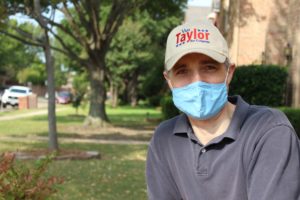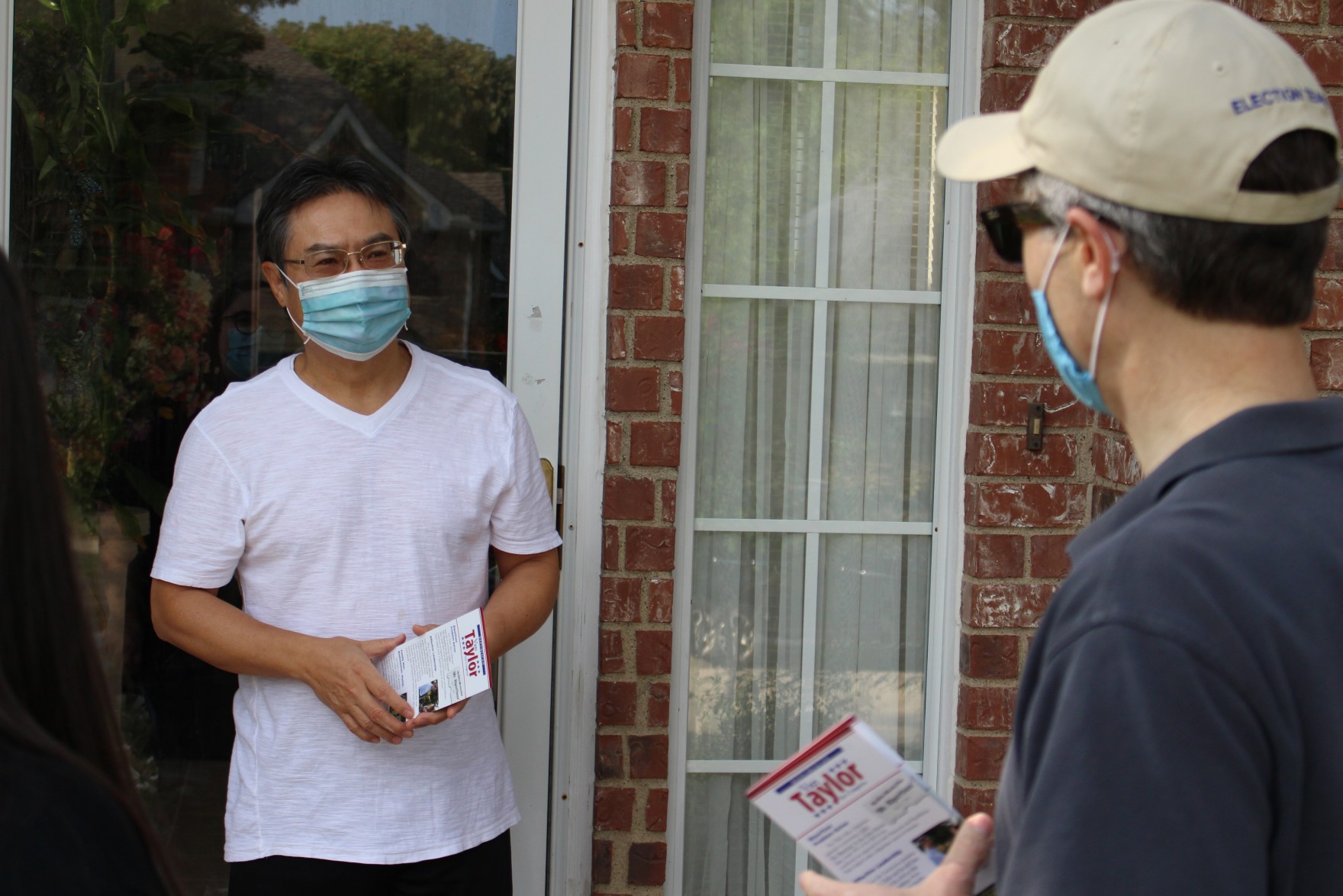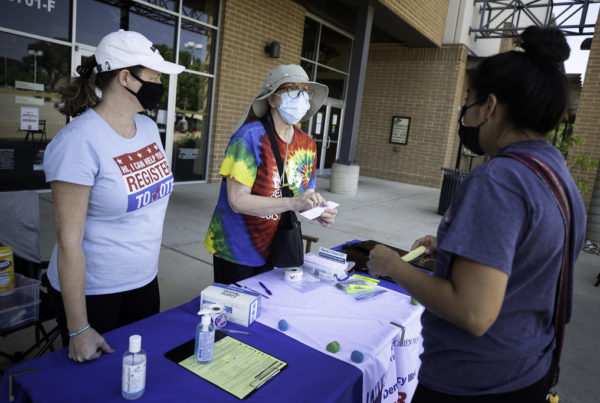From KERA:
Political campaigns in Texas and across the country are laser-focused on the rapidly-diversifying suburbs. One of the nation’s most-watched suburbs is Collin County, north of Dallas, which covers roughly the same area as Texas’ 3rd Congressional District. Long a Republican stronghold, the district is seeing a competitive race with two distinct candidates.
Political campaigns in Texas and across the country are laser-focused on the rapidly-diversifying suburbs. One of the nation’s most-watched suburbs is Collin County, north of Dallas, which covers roughly the same area as Texas’ 3rd Congressional District. Long a Republican stronghold, the district is seeing a competitive race with two distinct candidates.

Republican U.S. Rep. Van Taylor represents Texas’ 3rd Congressional District.
The Incumbent
Republican Van Taylor is a fixture in Collin County. Before winning the 3rd Congressional District seat two years ago, he was a state lawmaker for eight years.
“I started in politics as a precinct chair here in Plano,” he told a group of volunteers ahead of campaign canvassing in early October. “And watch out, [because] you never know where that’s gonna take you.”
As he greeted people on the doors, Taylor mentioned his time as an officer in the Marine Corps serving in the Iraq War, as well as his tenure in the Texas Legislature.
One of those home visits was to John Hunt of Plano, who voted for Taylor in 2018, aiding the congressman’s 10-point victory that year.
“My faith is important to me,” he told Taylor. “And I’m pro-life. So [I’m] reading as much as I possibly can about Amy Coney Barrett, and I’m really happy.”
Hunt’s stance against abortion means he will not be voting for former Vice President Joe Biden, who favors a woman’s right to choose. He’s undecided about voting for President Trump, although he is happy with Barrett and the president’s other judicial nominations.
Taylor has been a reliable vote for President Trump as a member of Congress, although he strikes a more moderate tone. He’ll need it. Democrats are targeting this seat, with the kind of health care message they think was so successful in 2018.

Lulu Seikaly and a supporter in early October. Seikaly is a Democrat running for Congress in Texas’ 3rd district.
The Challenger
Taylor’s competition in 2020 is Democrat Lulu Seikaly, a Plano lawyer. Like other Democrats, she talks a lot about health care.
“People are concerned about their health care,” Seikaly said. “How they’re going to afford it, how we’re going to cover as many people as we can, how we’re going to maintain the highest quality of insurance for people.”
Driving up to an outdoor event where Seikaly handed out yard signs, supporter Karen Mott introduced herself to Seikaly by saying “we love you.” Seikaly soon mentioned the Affordable Care Act (ACA), and Mott, a registered nurse, declared “health care is why I became a Democrat and left the Republican Party.”
Mott has employer-based insurance through her husband, not the ACA’s health insurance exchanges. Still, some of the ACA’s other reforms have been crucial for her family.
“I was able to keep both my children, who were just in college, on our health insurance until they were 26,” she said. Mott also said because of the law, her son, who has autism and several health issues, was able to take less than a full course load in college and not lose coverage.
Karen Mott herself isn’t a persuadable voter, but college-educated women like her are where many campaigns are focusing their energy. Over half of the residents over 25 in this district have a four-year college degree, compared to about a third of the nationwide population. Texas’ 3rd is one of the most educated congressional districts in the country.
Seikaly also talks about her personal story as a first generation Lebanese American who has experienced racism.
“What if a little girl, who’s feeling the way I felt after 9-11, is feeling the same way because we have a president who’s in the White House who’s spewing all this hateful rhetoric?” she said.
Health Care
On the Affordable Care Act, Taylor said he hears lots of complaints about high costs. To fight that, he wants to increase the number of people getting health care degrees.
“You lower the cost of something by increasing the supply,” he said. “That means reducing red tape, increasing the supply, and ultimately lowering health care costs to make it more affordable for everybody.”
Premiums have risen in both workplace and Affordable Care Act marketplace plans since Obamacare went into effect, a result of the additional benefits insurers are now required to cover. Those include mental health and maternity care.
Despite the higher cost, many other provisions of the law are popular, like coverage for pre-existing conditions. Before the Affordable Care Act, Texas had one of the most lightly-regulated health insurance markets in the country. Insurers could deny coverage of a pre-existing condition and charge women more than men, according to the New York Times.
Taylor wouldn’t say whether he agreed with the Texas lawsuit seeking to invalidate the law. The U.S. Supreme Court will hear the case a week after the election, and there are a range of possible outcomes.
“I think the bigger question to ask is, does the current system work? And I think the answer is, it’s not working,” Taylor said.
The District
Voter Arash Payrovan has seen a lot of change in 20 years.
“When I went to [school in] Plano, graduated with 1,400 kids, there was probably like 100” non-white people, said Payrovan, who is Iranian American. “And now you look at it, it’s the complete opposite.”
Census estimates say Texas’ 3rd Congressional District has gained over 147,000 people and become 5.6% less white since 2013.
The shift in diversity has coincided with a shift in political leanings.
Jeff Blaylock, publisher of the subscription website Texas Election Source, said in 2002, the precincts that are now in Texas’ 3rd Congressional district were 17.4% more Republican than the state as a whole.
“In 2018, it was 1.8 points redder than the state as a whole,” he said. “That’s a fairly dramatic shift.”
In his 2018 Senate race, Democrat Beto O’Rourke courted voters of color and young voters but lost the 3rd Congressional narrowly, as he did statewide.
But the result still sent a motivating message, according to Bernard Fraga, a political scientist at Emory University. Fraga said talking directly to communities of color signals their vote matters.
“When a group that is important to you, an identity that is important to you is prioritized by campaigns, is really talked about by campaigns … that’s when you’re more likely to see higher voter turnout from members of that group,” Fraga said.
Payrovan isn’t familiar yet with his Congressional choices. In a year with a noisy presidential race and a cascade of down ballot names, it’ll be hard for any local campaign to break through.
Van Taylor argued business and population growth here proves the success of Republican governance, calling it “a statement of support.”
We’ll see if voters agree.
Got a tip? Email Bret Jaspers at bjaspers@kera.org. You can follow Bret on Twitter @bretjaspers.















